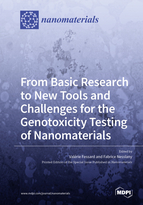From Basic Research to New Tools and Challenges for the Genotoxicity Testing of Nanomaterials
A special issue of Nanomaterials (ISSN 2079-4991).
Deadline for manuscript submissions: closed (18 June 2020) | Viewed by 46255
Special Issue Editors
Interests: toxicology; DNA damage; food contaminants
Special Issue Information
Dear Colleagues,
This Special Issue is open to contributions presenting studies on the genotoxicity of nanomaterials. The human population is exposed to a broad diversity of nanomaterials either manufactured or found naturally. Issues are regularly faced when addressing risk assessments for nanomaterials, and their increasing use in consumer products raises public health concerns. Although tremendous data have been published or provided during collaborative funded projects, conclusions on the genotoxicity of well-known nanomaterials are controversial, the key drivers involved in the genotoxic response of nanomaterials are still unclear, as are the underlying mechanisms. Moreover, the assay conditions for genotoxicity testing are still debated.
Papers reporting on the following are welcome: i) the role of the physico-chemical characteristics of nanomaterials (shape, size, protein corona, coating) including modifications occurring throughout their lifecycle as part of the genotoxic response; ii) investigation of the interference with in vitro genotoxicity assays including improved protocols or new methods to overcome this interference; iii) conditions for genotoxicity testing including the cell line(s) to be used, maximum dose/concentration and the method of nanomaterial dispersion; iv) proposals for nanomaterial reference controls; and finally v) the development of new tools as well as new approaches (grouping, ranking, safe(r)-by-design, read-across, etc.) to improve and facilitate genotoxicity testing.
Dr. Valérie FESSARD
Dr. Fabrice Nesslany
Guest Editors
Manuscript Submission Information
Manuscripts should be submitted online at www.mdpi.com by registering and logging in to this website. Once you are registered, click here to go to the submission form. Manuscripts can be submitted until the deadline. All submissions that pass pre-check are peer-reviewed. Accepted papers will be published continuously in the journal (as soon as accepted) and will be listed together on the special issue website. Research articles, review articles as well as short communications are invited. For planned papers, a title and short abstract (about 100 words) can be sent to the Editorial Office for announcement on this website.
Submitted manuscripts should not have been published previously, nor be under consideration for publication elsewhere (except conference proceedings papers). All manuscripts are thoroughly refereed through a single-blind peer-review process. A guide for authors and other relevant information for submission of manuscripts is available on the Instructions for Authors page. Nanomaterials is an international peer-reviewed open access semimonthly journal published by MDPI.
Please visit the Instructions for Authors page before submitting a manuscript. The Article Processing Charge (APC) for publication in this open access journal is 2900 CHF (Swiss Francs). Submitted papers should be well formatted and use good English. Authors may use MDPI's English editing service prior to publication or during author revisions.
Keywords
- in vitro and in vivo genotoxicity
- mutagenicity
- DNA damage
- mechanism of action
- reference material
- new tools
- interference
- physico-chemical drivers of genotoxicity
- lifecycle
- conditions of genotoxicity assays







